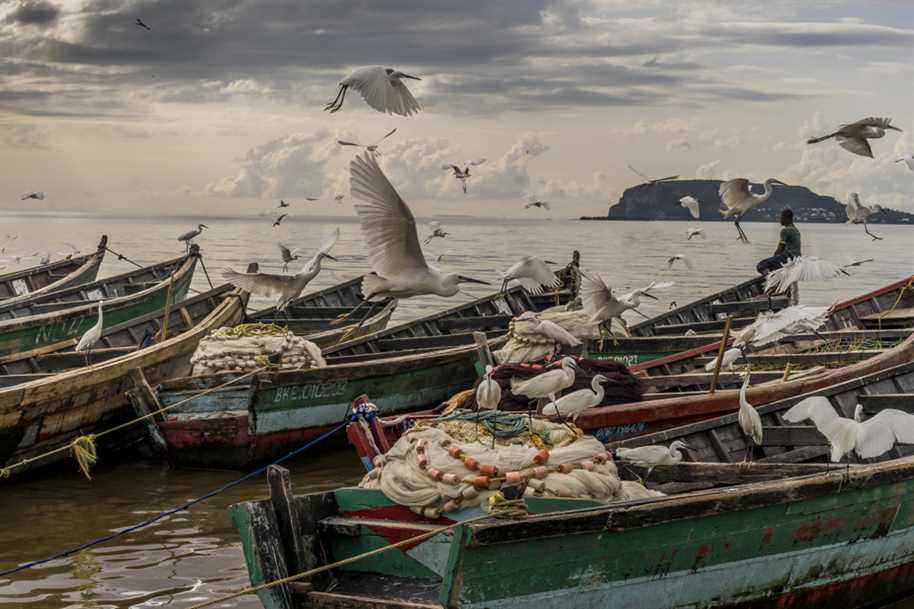
PHOTO MARTIN TREMBLAY, THE PRESS
The CEO of the Zoom Photo Festival, Michel Tremblay (on the left), and the president of the Maison de la photo de Québec, Pierre Vézina, organizers of the exhibition. The deployment includes some twenty photographic series presented in Saguenay last October. Series on pollution, the miners of a Canadian company in Colombia, the atmosphere in Paris in these times of COVID-19, the work of the Médecins sans frontières association, the genocide experienced by the Yazidis in Iraq, or again the consequences of climate change. “From this exhibition, we come out moved and worried,” says Pierre Vézina.

PHOTO JÉRÉMY LEMPIN, PROVIDED BY ZOOM
On November 30, 2020, 24-year-old Manon, with generalized cancer, and her 7-year-old son Ethan are hugged at the Palliative Care Center at Calais Hospital in France in the presence of the horse Peyo. The series by French photographer Jérémy Lempin focuses on this particular horse, nicknamed Doctor Peyo, who enjoys warm contact with human beings who are morally, physically or psychologically weakened.

PHOTO LUIS TATO, WASHINGTON POST, PROVIDED BY ZOOM
Kenyan Henry Lenayasa is caught in a Desert Locust cloud at Archers Post, Samburu County, Kenya in April 2020. Clouds of millions of these insects have regularly devastated vast areas of East Africa since then. several years, in part because of climate change.

PHOTO MARTIN TREMBLAY, THE PRESS
In the entrance to Espace 400e, the On the Tip of the Toes Foundation, which organizes “therapeutic adventures” for young people with cancer, exhibits photographs of these challenges that allow children to change their minds, to keep confidence and to live strong moments with d ‘other young people with just as much need to recharge their batteries.

PHOTO MARTIN TREMBLAY, THE PRESS
Quebec photojournalist Roger Lemoyne presents his project to Zoom Who owns Colombia’s gold?, centered around the gold mines that the Canadian mining company Gran Colombia Gold operates around the towns of Marmato and Ségovia, in Colombia.

PHOTO ROGER LEMOYNE, PROVIDED BY ZOOM
Miners unload sacks of ore at the Marmato mine in Colombia. One of the photographs in the series Who owns Colombia’s gold?, by photojournalist Roger Lemoyne.

PHOTO CHARLES-FRÉDÉRICK OUELLET AND NICOLAS LÉVESQUE, PROVIDED BY ZOOM
Charles-Frédéric Ouellet carried out photographic work in the Chute-des-Passes region, north of Lac Saint-Jean, following the gigantic fire that devastated 300 km2 nature in 2020. He documented the human presence in this region and initiated research on the theme of forest regeneration. A project supported by the Sagamie Center, Bande Son Image and local resources.

PHOTO ROGER LEMOYNE, SPECIAL COLLABORATION
The photojournalist of Press Martin Tremblay in front of his exhibition The Hidden History of Canadian Mining. It is part of the segment Towntainers of the exhibition. A reflection on the consequences of human intervention on nature, in which he participates with the photographers Nigel Dickinson, Abir Abdullah, Nicolas Lévesque and Charles-Frédérick Ouellet. In October, the works were shown on containers in Saguenay, giving the impression of a refugee camp. Hence the title Towntainers.

PHOTO MARTIN TREMBLAY, PROVIDED BY ZOOM
Saint-Joseph-de-Sorel, village dominated by the chimneys of heavy industries, in particular those of Rio Tinto Fer et Titane. Martin Tremblay’s photo essay showed that the population lives in the backyard of a huge metallurgical complex where, one day in three, the air was judged to be of poor quality. What makes this district the most polluted place in Quebec. Photo taken on Feb. 16, 2015, as part of work on the mining industry, which the photojournalist says cares little about the environment. Martin Tremblay traveled for six years in four mining regions in Quebec.

